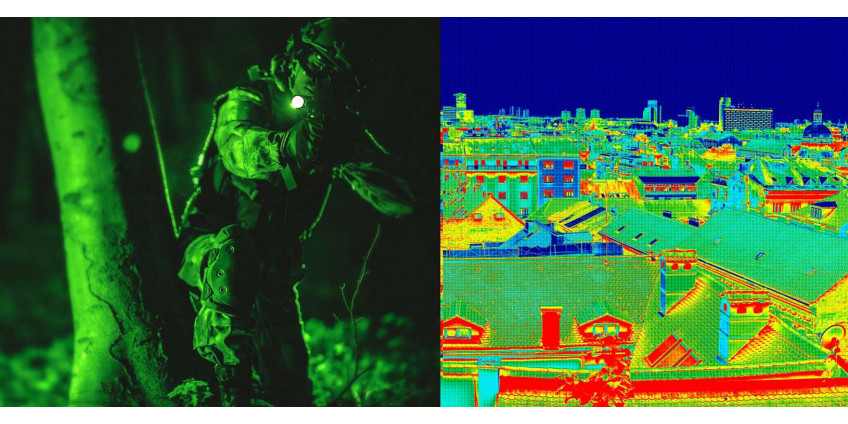
Thermal optics and night vision devices – do you need to choose one of two options? It seems to be quite difficult to do this. But in fact, the choice will become obvious as soon as you learn more about the features of each type. So let's understand, Is Thermal Imaging or Night Vision Right For you? Perhaps our article will help you save a good amount of money and quickly find an excellent option for your purposes.
Is Thermal Imaging or Night Vision Right For Me?
Before looking for an answer to this question, it is worth knowing how each type of optics works. So, first, let's find out how does thermal vision work? This type of optics is a new generation invention. The principle of work is based on capturing and measuring temperature. Every object has its temperature, even stones, and ground. Almost all objects generate heat, which is captured by the thermal sensors. Such optics can identify the heat stream of temperatures from 0.01 degrees.
Thermal optics has a good distance of heat identification, so it can find all heat sources in the selected territory, either weak or strong. The thermal image of the territory is displayed on the screen. It can be black and white or of different colors. The brighter or lighter the color, the more heat the object generates. If the thermal optics has a color screen, then each temperature will be displayed in its color.
Now let's find out how night vision devices work. The principle of their work is based on capturing light reflected from the objects. The objectives capture the reflected light flux and turn cathodes into electrons. Electrons pass through the image intensifier tube and hit the phosphor screen. The screen converts the electrons of light into a visible image. The more electrons enter the tube, the sharper and brighter the image will be.
Modern models of NV devices can work in complete darkness, but in this case, an infrared beam is used as a backlight. Neither man nor animal can see this beam. For the standard models of NV devices, it will be enough light from the stars and the moon. But sources of direct light, for example, lanterns, lamps, spotlights, can damage image intensifier tube.
But this is just a comparison between the principles of work. In real life, both types of optics have many other differences that you should pay attention to. Here are the main nuances that you should know about:
· Conditions of use. The thermal imager will find objects in poor visibility conditions, fog, and smoke, in the dense foliage of trees or bushes. Its sensors can see heat even through doors and thin walls. But the effectiveness of using such optics is reduced at low-temperature conditions. Night vision is not able to identify objects in poor visibility conditions, but it can show absolutely all objects, either motionless or cold. Also, the temperature is not important for such optics, it will work in heat and cold.
· Light sources. Thermal optics does not depend on it, the principle of its work is based on heat capturing. Therefore, it will equally well show the thermal image in the daytime and at night. Night vision requires at least a small source of light.
· Versatility in the application. Both types of optics can be mounted on hunting rifles. Professional hunters and wildlife watchers combine them for detailed observation of territory, objects, and target tracking. Night vision can easily identify the object and the distance to it. But if an animal or a human doesn’t move, such optics will be ineffective. Thermal optics help you find any warm object, even if it will not move. If you combine both types of optics, hunting or tracking the target will be much more convenient and effective.
· Price. The biggest difference between the optics is in its cost. Night vision can be purchased for $ 300-500. And it will be a good option with great image resolution and field of view. The thermal imager will cost about $2000 or more. Therefore, before buying, think carefully about what exactly you need.
If we compare the optics in terms of compactness and weight, then both options are quite small and light, some models may be carried in your pocket.
Pros and Cons: Thermal Imagers vs. Night Vision
The easiest way to choose any optics is to know all its pros and cons. Due to this, you can quickly understand what suits your requirements and conditions of use.
Thermal Imagers
Night Vision
Summary
We have compared Thermal Optics and Night Vision in all possible parameters. So, thermal optics are very expensive, but you can see all objects that generate heat in any visibility day or night. The disadvantage is that in the cold season this optics becomes useless. Its sensors cannot capture heat at a distance due to very cold air. Besides, such optics needs to be warmed up, and the battery will drain quickly if the device is using constantly. To understand the image on the display, you need to have some experience of use.
Night vision devices are much simpler. Depending on the model, you can buy the device for a nice price. The picture is displayed in green color, but otherwise, it is the same as in daylight. Night vision has a good observation distance, even with minimal illumination of the territory. Such devices are very light, small in size, and can be attached to the rifles. But in fog, smog, or tall grass they will not show anything.
Whichever option you decide to buy, choose only reliable sellers. Defend and Carry (https://www.defendandcarry.com/) offers a large selection of optics for different conditions of use. We give a guarantee for all products because we work only with trusted suppliers. With us, hunting, wildlife watching, or any other type of activity will be easy and successful.
